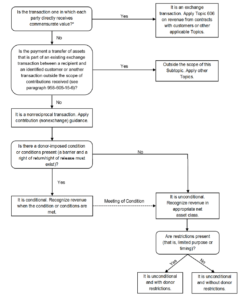Conditional Contributions? ASU 2018-08 Explains it All
Originally published on December 4, 2019
Updated on March 4th, 2024
We recently discussed ASU 2018-08, which addresses procedures to account for contributions and exchanges. Our previous article covered whether a transaction is a contribution or exchange. In this piece, we’ll explain how to determine whether a contribution is conditional or unconditional.
A contribution to your nonprofit is considered conditional when both of the following attributes are met:
- One or more barriers exist; and,
- The right to receive or retain payment or delivery of the promised asset depends on meeting those barriers.
Attribute 1 – The Barrier
Old standards cited that “barriers” made a contribution conditional. However, this term was vaguely defined as a “specified future and uncertain event.” ASU 2018-08 clearly establishes the requirements of a barrier.
A barrier is a level of service, a certain outcome, a match requirement or other measurable requirement. Examples include providing a set number of objects or services, incurring certain qualifying expenses (cost reimbursement grants) or adding specified square footage of building space. These are all measurable; trivial administrative requirements are not considered barriers.
Attribute 2 – Right to Receive or Retain
This means that you have the right to receive or retain the contribution once the barrier has been achieved. If the award money has been provided up front, this would be a liability until the condition was met. We’ll illustrate this with an example:
- A local library nonprofit has been given $10,000 to provide 1000 books to local schools.
- Any unused funds must be returned.
The barrier is the measurable amount-in this case, the 1,000 books that must be provided with the money. The right to receive or retain is the condition that unused monies must be returned to the donor.
In some cases, the stipulations regarding the right of return or release of obligation might be difficult to determine. A contribution that is not clearly unconditional is presumed to be conditional.
A New Wrinkle: The Removal of Probability
Previously, if the likelihood of an organization not meeting the attributes was low, it wasn’t considered conditional. The new standards make it clear that probability is not a factor in determining if there is a barrier to overcome.
We’ll go back to our library nonprofit example. Let’s say that historically, the nonprofit provides 5,000 books annually to local schools. This is well under the 1,000 books stipulated by the barrier criteria. Statistically, the likelihood of the nonprofit not meeting this barrier is remote.
Under old standards, it would not have been considered a conditional contribution. Per ASU 2018-08, however, probability is not considered. So the barrier (providing 1,000 books) and right to retain (money requirement) on their own make the contribution conditional.
Revenue Recognition: The Final Step
If your contribution is classified as unconditional, your organization will recognize revenue in the appropriate net asset class. You would then determine if there are donor restrictions. Revenue from a conditional contribution is recognized when conditions are met.
The Financial Accounting Standards Board has created a flowchart to better illustrate this entire process.

Remember, a condition requires both a barrier and a right of return/release. The standards to determine restrictions has not changed. Restrictions limit a use or affect when then contribution is used in a more narrow circumstance than the organization usually follows. They do not affect whether your nonprofit is entitled to the contribution. Restrictions are a presentation issue, not a recognition issue.
The effective date for nonprofits classified as public entities is annual periods beginning after Dec. 15, 2018. This date is pushed one year later (Dec. 15, 2019) for all other nonprofits. Early adoption is permitted.
ASU 2018-08 could significantly change the way you recognize revenues throughout the year. They might also affect the disclosures on your financial statements. It is important to review contracts and grants now to ensure proper classification, recognition, and disclosure. Contacting a nonprofit CPA to guide you in this task will help ensure you’re following the new standards correctly.
All content provided in this article is for informational purposes only. Matters discussed in this article are subject to change. For up-to-date information on this subject please contact a James Moore professional. James Moore will not be held responsible for any claim, loss, damage or inconvenience caused as a result of any information within these pages or any information accessed through this site.
Other Posts You Might Like

